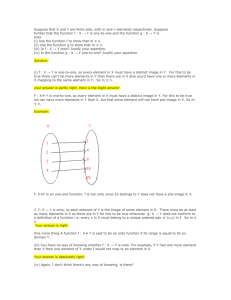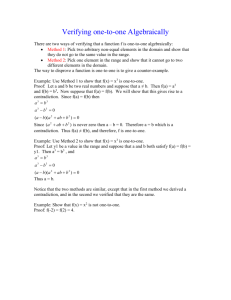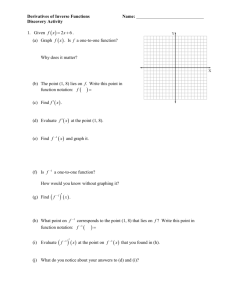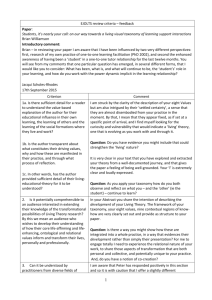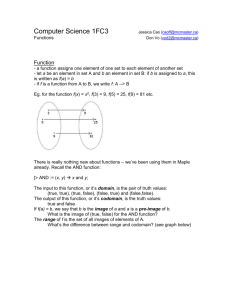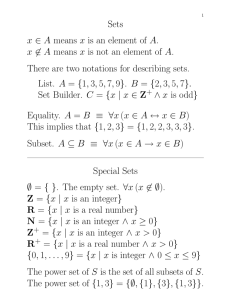One-to-One Functions & Inverses: Lecture Notes
advertisement
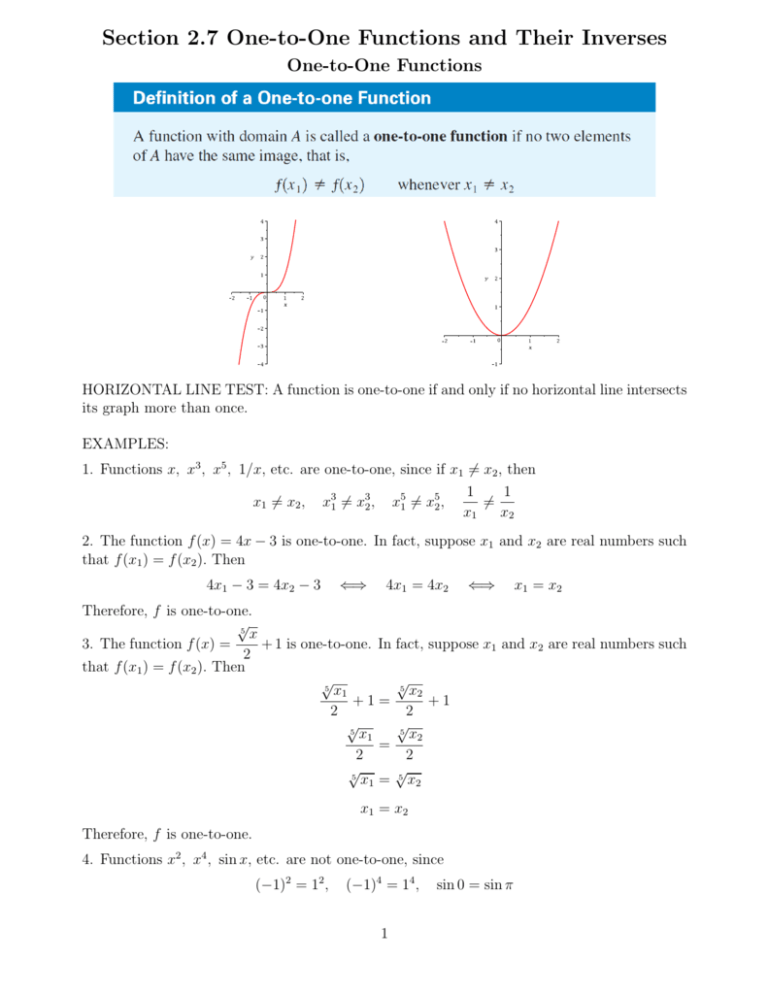
Section 2.7 One-to-One Functions and Their Inverses One-to-One Functions HORIZONTAL LINE TEST: A function is one-to-one if and only if no horizontal line intersects its graph more than once. EXAMPLES: 1. Functions x, x3 , x5 , 1/x, etc. are one-to-one, since if x1 = 6 x2 , then 1 1 6= x1 6= x2 , x31 6= x32 , x51 6= x52 , x1 x2 2. The function f (x) = 4x − 3 is one-to-one. In fact, suppose x1 and x2 are real numbers such that f (x1 ) = f (x2 ). Then 4x1 − 3 = 4x2 − 3 ⇐⇒ 4x1 = 4x2 ⇐⇒ x1 = x2 Therefore, f is one-to-one. √ 5 x 3. The function f (x) = + 1 is one-to-one. In fact, suppose x1 and x2 are real numbers such 2 that f (x1 ) = f (x2 ). Then √ √ 5 x 5 x 1 2 +1= +1 2 2 √ √ 5 x 5 x 1 2 = 2 2 √ √ 5 x1 = 5 x2 x1 = x2 Therefore, f is one-to-one. 4. Functions x2 , x4 , sin x, etc. are not one-to-one, since (−1)2 = 12 , (−1)4 = 14 , 1 sin 0 = sin π DEFINITION: Let f be a one-to-one function with domain A and range B. Then its inverse function f −1 has domain B and range A and is defined by f −1 (y) = x ⇐⇒ f (x) = y (∗) for any y in B. So, we can reformulate (∗) as (f −1 ◦ f )(x) = f −1 (f (x)) = x for every x in the domain of f (f ◦ f −1 )(x) = f (f −1 (x)) = x for every x in the domain of f −1 IMPORTANT: Do not confuse f −1 with 1 . f EXAMPLES: 1. Let f (x) = x3 , then f −1 (x) = √ 3 x, since √ √ √ 3 f −1 (f (x)) = f −1 (x3 ) = x3 = x and f (f −1 (x)) = f ( 3 x) = ( 3 x)3 = x √ 2. Let f (x) = x3 + 1, then f −1 (x) = 3 x − 1, since p √ √ f −1 (f (x)) = f −1 (x3 +1) = 3 (x3 + 1) − 1 = x and f (f −1 (x)) = f ( 3 x − 1) = ( 3 x − 1)3 +1 = x 1 3. Let f (x) = 2x, then f −1 (x) = x, since 2 1 1 1 −1 −1 −1 f (f (x)) = f (2x) = (2x) = x and f (f (x)) = f x =2 x =x 2 2 2 4. Let f (x) = x, then f −1 (x) = x, since f −1 (f (x)) = f −1 (x) = x and f (f −1 (x)) = f (x) = x x−2 , since 7 x−2 x−2 (7x + 2) − 2 −1 −1 −1 = x and f (f (x)) = f =7 +2 = x f (f (x)) = f (7x+2) = 7 7 7 5. Let f (x) = 7x + 2, then f −1 (x) = Solution: Step 1: Replace f (x) by y: y = 7x + 2 Step 2: Solve for x: y = 7x + 2 =⇒ y − 2 = 7x Step 3: Replace x by f −1 (x) and y by x: f −1 (x) = 6. Let f (x) = (3x − 2)5 + 2. Find f −1 (x). 2 x−2 7 =⇒ y−2 =x 7 6. Let f (x) = (3x − 2)5 + 2. Find f −1 (x). Solution: Step 1: Replace f (x) by y: y = (3x − 2)5 + 2 Step 2: Solve for x: y = (3x−2)5 +2 =⇒ y −2 = (3x−2)5 therefore =⇒ √ 5 p 5 y − 2 = 3x−2 y−2+2 3 −1 Step 3: Replace x by f (x) and y by x: √ 5 x−2+2 −1 f (x) = 3 x= 7. Let f (x) = 3x − 5 . Find f −1 (x). 4 − 2x 8. Let f (x) = √ x. Find f −1 (x). 3 =⇒ p 5 y − 2+2 = 3x 7. Let f (x) = Solution: 3x − 5 4x + 5 , then f −1 (x) = . 4 − 2x 3 + 2x Step 1: Replace f (x) by y: 3x − 5 4 − 2x y= Step 2: Solve for x: y= 3x − 5 4 − 2x =⇒ y(4 − 2x) = 3x − 5 =⇒ 4y − 2xy = 3x − 5 therefore 4y + 5 = x(3 + 2y) =⇒ =⇒ 4y + 5 = 3x + 2xy 4y + 5 =x 3 + 2y Step 3: Replace x by f −1 (x) and y by x: f −1 (x) = 8. Let f (x) = √ 4x + 5 3 + 2x x, then f −1 (x) = x2 , x ≥ 0. IMPORTANT: domain of f −1 = range of f range of f −1 = domain of f 9. Let f (x) = √ 3 − x, then f −1 (x) = 3 − x2 , x ≥ 0. Solution: Step 1: Replace f (x) by y: y= √ Step 2: Solve for x: y= √ 3−x =⇒ 3−x y2 = 3 − x =⇒ x = 3 − y2 Step 3: Replace x by f −1 (x) and y by x: f −1 (x) = 3 − x2 Since the range of f (x) is all nonnegative numbers, it follows that the domain of f −1 (x) is x ≥ 0. So, f −1 (x) = 3 − x2 , x ≥ 0 4 10. Let f (x) = √ 11. Let f (x) = √ 4 12. Let f (x) = √ 13. Let f (x) = √ 4 1 3x − 2, then f −1 (x) = (x2 + 2), x ≥ 0 (see Appendix, page 7). 3 x − 1, then f −1 (x) = x4 + 1, x ≥ 0 (see Appendix, page 7). x + 5 + 1, then f −1 (x) = (x − 1)2 − 5, x ≥ 1 (see Appendix, page 8). 2x − 7 + 5, then f −1 (x) = (x − 5)4 + 7 , x ≥ 5 (see Appendix, page 8). 2 14. The function f (x) = x2 is not invertible, since it is not a one-to-one function. REMARK: Similarly, x4 , x10 , sin x, cos x, are not invertable functions. 15. The function f (x) = (x + 1)2 is not invertible. 16. Let f (x) = x2 , x ≥ 0, then f −1 (x) = 17. Let f (x) = x2 , x ≥ 2, then f −1 (x) = √ √ x, x ≥ 0. x, x ≥ 4. √ 18. Let f (x) = x2 , x < −3, then f −1 (x) = − x, x > 9. 19. The function f (x) = x2 , x > −1 is not invertible. 20. Let f (x) = (x + 1)2 , x > 3. Find f −1 (x). 21. Let f (x) = (1 + 2x)2 , x ≤ −1. Find f −1 (x). 5 etc. 20. Let f (x) = (x + 1)2 , x > 3, then f −1 (x) = 2 21. Let f (x) = (1 + 2x) , x ≤ −1, then f −1 √ x − 1, x > 16 (see Appendix, page 9). (x) = − √ x+1 , x ≥ 1 (see Appendix, page 9). 2 THEOREM: If f has an inverse function f −1 , then the graphs of y = f (x) and y = f −1 (x) are reflections of one another about the line y = x; that is, each is the mirror image of the other with respect to that line. EXAMPLE: The graph of a function f is given. Sketch the graph of f −1 . Solution: 6 Appendix 10. Let f (x) = √ 1 3x − 2, then f −1 (x) = (x2 + 2), x ≥ 0. 3 Solution: Step 1: Replace f (x) by y: y= √ 3x − 2 Step 2: Solve for x: y= √ 3x − 2 =⇒ y 2 = 3x − 2 =⇒ y 2 + 2 = 3x therefore 1 x = (y 2 + 2) 3 −1 Step 3: Replace x by f (x) and y by x: 1 f −1 (x) = (x2 + 2) 3 Finally, since the range of f is all nonnegative numbers, it follows that the domain of f −1 is x ≥ 0. 11. Let f (x) = √ 4 x − 1, then f −1 (x) = x4 + 1, x ≥ 0. Solution: Step 1: Replace f (x) by y: y= Step 2: Solve for x: y= √ 4 x−1 √ 4 x−1 =⇒ y4 = x − 1 therefore x = y4 + 1 Step 3: Replace x by f −1 (x) and y by x: f −1 (x) = x4 + 1 Finally, since the range of f is all nonnegative numbers, it follows that the domain of f −1 is x ≥ 0. 7 12. Let f (x) = √ x + 5 + 1, then f −1 (x) = (x − 1)2 − 5, x ≥ 1. Solution: Step 1: Replace f (x) by y: y= Step 2: Solve for x: √ y = x+5+1 =⇒ √ x+5+1 y−1= √ x+5 =⇒ (y − 1)2 = x + 5 therefore x = (y − 1)2 − 5 Step 3: Replace x by f −1 (x) and y by x: f −1 (x) = (x − 1)2 − 5 Finally, since the range of f is all numbers ≥ 1, it follows that the domain of f −1 is x ≥ 1. 13. Let f (x) = √ 4 2x − 7 + 5, then f −1 (x) = (x − 5)4 + 7 , x ≥ 5. 2 Solution: Step 1: Replace f (x) by y: y= Step 2: Solve for x: √ y = 4 2x − 7 + 5 =⇒ y−5 = √ 4 2x − 7 √ 4 2x − 7 + 5 =⇒ (y − 5)4 = 2x − 7 =⇒ (y − 5)4 + 7 = 2x therefore (y − 5)4 + 7 2 −1 Step 3: Replace x by f (x) and y by x: x= f −1 (x) = (x − 5)4 + 7 2 Finally, since the range of f is all numbers ≥ 5, it follows that the domain of f −1 is x ≥ 5. 8 20. Let f (x) = (x + 1)2 , x > 3, then f −1 (x) = √ x − 1, x > 16. Solution: Step 1: Replace f (x) by y: y = (x + 1)2 Step 2: Solve for x: √ y = (x + 1)2 =⇒ ± y = x + 1 √ Since x is positive, it follows that y = x + 1, therefore x= √ y−1 Step 3: Replace x by f −1 (x) and y by x: f −1 (x) = √ x−1 To find the domain of f −1 we note that the range of f is all numbers > 16. Indeed, since x > 3, we have f (x) = (x + 1)2 > (3 + 1)2 = 42 = 16 From this it follows that the domain of f −1 is x > 16. 2 21. Let f (x) = (1 + 2x) , x ≤ −1, then f −1 (x) = − √ x+1 , x ≥ 1. 2 Solution: Step 1: Replace f (x) by y: y = (1 + 2x)2 Step 2: Solve for x: √ y = (1 + 2x)2 =⇒ ± y = 1 + 2x √ Since x ≤ −1, it follows that − y = 1 + 2x, hence √ − y − 1 = 2x =⇒ − √ y+1 =x 2 Step 3: Replace x by f −1 (x) and y by x: f −1 (x) = − √ x+1 2 To find the domain of f −1 we note that the range of f is all numbers ≥ 1. Indeed, since x ≤ −1, we have f (x) = (1 + 2x)2 ≥ (1 + 2 · (−1))2 = (1 − 2)2 = (−1)2 = 1 From this it follows that the domain of f −1 is x ≥ 1. 9
